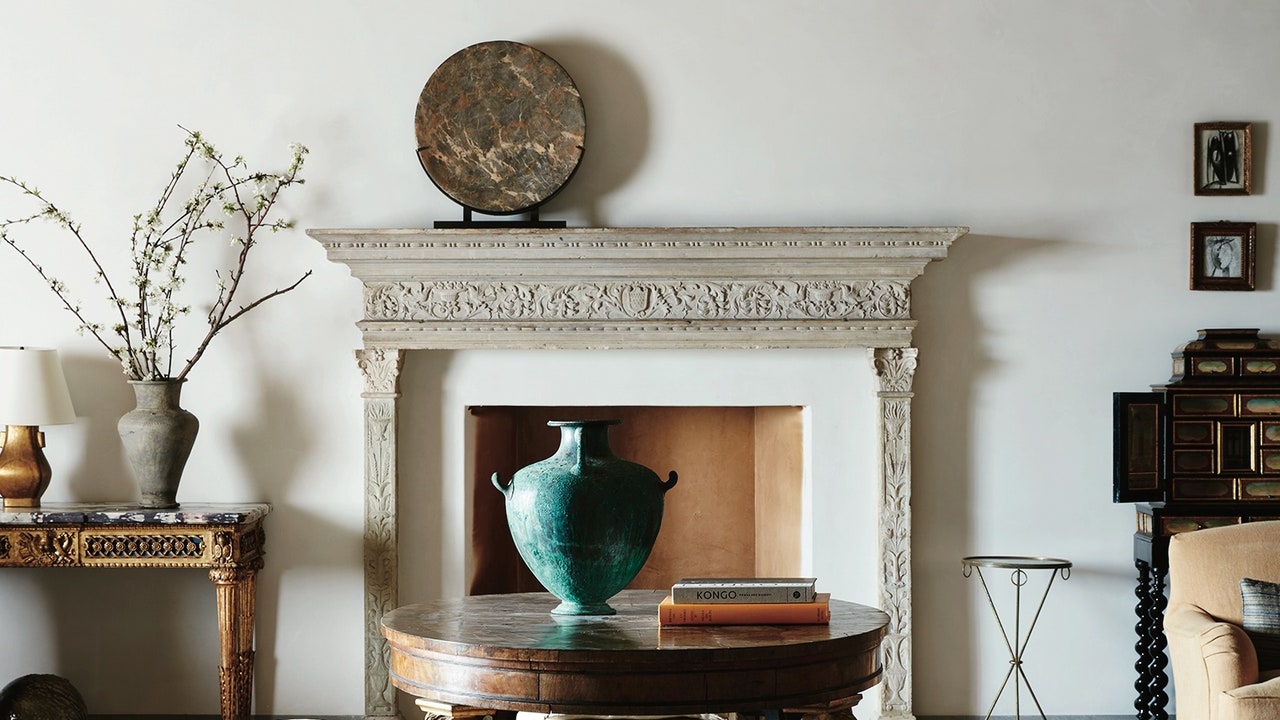Maybe you have an ornate mantel wrapped in marble and intricate millwork, or perhaps you’re working with a charming, timeworn brick surround—either way, having a fireplace (working or not!) in your home feels like hitting the design jackpot.
There’s a reason why so many consider it the true heart of the home. It’s more than just a decorative detail but a natural gathering spot and prime stage for displaying meaningful treasures, family photos, and collected decor. But dressing it can be more complex than it seems, offering an exercise in both intention and restraint to achieve that just-right juxtaposition. It’s as much about editing as it is about styling.
It seems simple enough—but too little on there? It feels bare and lonely. Too many vases and sculptural objects? It quickly becomes cluttered. The key is finding a visual rhythm, which is why we tapped some of our favorite designers to share how they approach arranging a mantel. Whether it’s starting with symmetry and then artfully unraveling it or bringing in a touch of nature for dramatic effect, here’s how to create a curated vignette—versus a catch-all—to turn your mantel into a moment.
Photographed by Yoshihiro Makino, Architectural Digest, March 2022
Start With Symmetry
Most designers agree the secret to a well-appointed mantel is asymmetry. But that’s not always immediately achieved. In fact, Interior designer Adam Charlap Hyman of AD100 firm Charlap Hyman & Herrero recommends starting with symmetry. “To start, arrange the mantel in its most formal, original state—completely symmetrical. Starting from the edges, add in anchoring items that come in a pair—like a set of lamps or candlesticks—and then begin to work your way in.”
Purposefully Break It Up
Once you’ve established your base layer, you can begin to “dishevel it a bit,” as Hyman puts it—adding in those imperfect touches that make the arrangement feel lived-in and effortless. “Layer with intention and a touch of asymmetry,” AD100 designer Brigette Romanek shares with Vogue. “Play with height, texture, and scale to bring depth and character, but don’t overthink perfection—a little imbalance makes a space feel more inviting. Offset a striking vase with a small stack of books or an unexpected decorative piece to keep the arrangement dynamic and personal,” she adds. This can be done by adding in sculptural objects—like a tall hand-thrown vase or marble sphere—or quirky flea market finds.
In fact, a mantel is the perfect perch for smaller decorative pieces or meaningful knick-knacks. “I don’t like having clutter in my kitchen, so the mantel is the place where I will have little trinkets and pieces I have collected over time—it sort of tells a story,” shares British designer and founder of MG&Co., Matilda Goad. AD100 designer Heidi Caillier agrees, “I love to style little treasures I’ve procured while traveling. They are great conversation starters.”
Photographed by Yoshihiro Makino, Architectural Digest, March 2022
Layer Your Light
What’s a mantel without a little glow? Whether it’s tea lights, tapers, or pillar candles, layering different light sources is essential for bringing a warm, moody vibe to your mantel. “A pair of sconces or the flicker of candlelight instantly warms up a space. I love adding taper candles in beautifully crafted holders—they create a sense of intimacy, making the mantel feel considered yet inviting,” Romanek says.
Goad echoes this sentiment. “You will always find a mix of candles on my mantel—scented ones (Eym ‘Home’ is my favorite) alongside the ribbed beeswax candles from my own line. I also love alabaster tea lights that glow.”
Bring Nature In
Whether it’s a floral clipping from your garden, a found branch, or a store-bought bouquet, nature adds a sculptural element to the display while also channeling the calmness of the outdoors. Romanek suggests asymmetrical, unexpected greenery—like delicate quince branches, a lush explosion of jasmine, or wild, wispy grasses. “It creates a sense of movement and effortless sophistication. Think of it as a conversation between indoors and out, bringing an organic element that feels fresh and personal rather than predictable,” she shares.
Read the full article here




